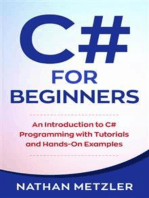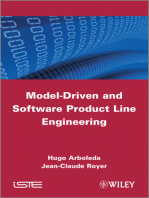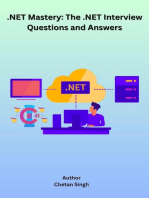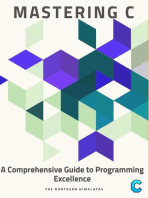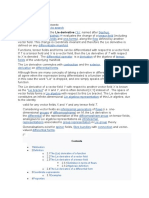code-generation-using-machine-learning-a-systematic-review-1ic7hqvz_Extracted
Uploaded by
Jamoni Jamocode-generation-using-machine-learning-a-systematic-review-1ic7hqvz_Extracted
Uploaded by
Jamoni JamoThis article has been accepted for publication in IEEE Access.
This is the author's version which has not been fully edited and
content may change prior to final publication. Citation information: DOI 10.1109/ACCESS.2022.3196347
Date of publication xxxx 00, 0000, date of current version xxxx 00, 0000.
Digital Object Identifier 10.1109/ACCESS.2017.DOI
Code Generation Using Machine
Learning: A Systematic Review
ENRIQUE DEHAERNE1,2 (Graduate Student Member, IEEE), BAPPADITYA DEY2
(Graduate Student Member, IEEE), SANDIP HALDER2 , STEFAN DE GENDT1,3 (Senior
Member, IEEE), and WANNES MEERT1 (Member, IEEE).
1
Dept. of Computer Science, KU Leuven, 3001 Leuven, Belgium (e-mail: Enrique.Dehaerne@student.kuleuven.be, Wannes.Meert@kuleuven.be)
2
Interuniversity Microelectronics Centre (imec), Kapeldreef 75, 3001 Leuven, Belgium (e-mails: {Bappaditya.Dey, Sandip.Halder, Stefan.DeGendt}@imec.be)
3
Dept. of Chemistry, KU Leuven, 3001 Leuven, Belgium (e-mail: stefan.degendt@kuleuven.be)
Corresponding author: Enrique Dehaerne (e-mail: enrique.dehaerne@student.kuleuven.be).
ABSTRACT Recently, machine learning (ML) methods have been used to create powerful language
models for a broad range of natural language processing tasks. An important subset of this field is that
of generating code of programming languages for automatic software development. This review provides a
broad and detailed overview of studies for code generation using ML. We selected 37 publications indexed
in arXiv and IEEE Xplore databases that train ML models on programming language data to generate code.
The three paradigms of code generation we identified in these studies are description-to-code, code-to-
description, and code-to-code. The most popular applications that work in these paradigms were found to
be code generation from natural language descriptions, documentation generation, and automatic program
repair, respectively. The most frequently used ML models in these studies include recurrent neural networks,
transformers, and convolutional neural networks. Other neural network architectures, as well as non-neural
techniques, were also observed. In this review, we have summarized the applications, models, datasets,
results, limitations, and future work of 37 publications. Additionally, we include discussions on topics
general to the literature reviewed. This includes comparing different model types, comparing tokenizers,
the volume and quality of data used, and methods for evaluating synthesized code. Furthermore, we provide
three suggestions for future work for code generation using ML.
INDEX TERMS Automatic programming, Computer languages, Data collection, Machine Learning,
Natural language processing, Neural networks, Recurrent neural networks, Software debugging, Software
maintenance, Text mining.
I. INTRODUCTION
S OFTWARE development is a complex and time-
consuming process. It consists of two main phases: anal-
ysis and coding [1]. In the analysis phase, the requirements
and architecture of the software system are formalized. In the
coding phase, source code is written and tested to meet the
requirements set in the first phase. Usually, maintenance of
the system is included as an additional phase in the software
development cycle where previous steps can be adapted to FIGURE 1. An example model for software development with three phases,
reflect changes in the needs of the system user. Figure 1 each consisting of multiple steps. Software development models used in
practice vary in the number of steps and their ordering compared to the model
shows a flowchart for a simple software development model. depicted in this flowchart.
In this review, we focus on the coding phase which works
directly with source code.
Modern society relies on complex software applications. many programming languages (PLs) by many teams of devel-
These applications can consist of millions of lines written in opers. Even small software projects will often leverage large
VOLUME 4, 2016 1
This work is licensed under a Creative Commons Attribution 4.0 License. For more information, see https://creativecommons.org/licenses/by/4.0/
You might also like
- C# For Beginners: An Introduction to C# Programming with Tutorials and Hands-On ExamplesFrom EverandC# For Beginners: An Introduction to C# Programming with Tutorials and Hands-On Examples5/5 (1)
- EgoCoder - Intelligent Program Synthesis With Hierarchical Sequential Neural Network ModelNo ratings yetEgoCoder - Intelligent Program Synthesis With Hierarchical Sequential Neural Network Model10 pages
- Basics of Programming: A Comprehensive Guide for Beginners: Essential Coputer Skills, #1From EverandBasics of Programming: A Comprehensive Guide for Beginners: Essential Coputer Skills, #1No ratings yet
- Mastering the Craft: Unleashing the Art of Software EngineeringFrom EverandMastering the Craft: Unleashing the Art of Software EngineeringNo ratings yet
- Programming Best Practices for New Developers: A Practical Guide with ExamplesFrom EverandProgramming Best Practices for New Developers: A Practical Guide with ExamplesNo ratings yet
- Algorithms Made Simple: Understanding the Building Blocks of SoftwareFrom EverandAlgorithms Made Simple: Understanding the Building Blocks of SoftwareNo ratings yet
- C# Debugging from Scratch: A Practical Guide with ExamplesFrom EverandC# Debugging from Scratch: A Practical Guide with ExamplesNo ratings yet
- Writing Clean Code Step by Step: A Practical Guide with ExamplesFrom EverandWriting Clean Code Step by Step: A Practical Guide with ExamplesNo ratings yet
- CODING FOR ABSOLUTE BEGINNERS: How to Keep Your Data Safe from Hackers by Mastering the Basic Functions of Python, Java, and C++ (2022 Guide for Newbies)From EverandCODING FOR ABSOLUTE BEGINNERS: How to Keep Your Data Safe from Hackers by Mastering the Basic Functions of Python, Java, and C++ (2022 Guide for Newbies)No ratings yet
- Professional Test Driven Development with C#: Developing Real World Applications with TDDFrom EverandProfessional Test Driven Development with C#: Developing Real World Applications with TDDNo ratings yet
- Image Collection Exploration: Unveiling Visual Landscapes in Computer VisionFrom EverandImage Collection Exploration: Unveiling Visual Landscapes in Computer VisionNo ratings yet
- C# Algorithms for New Programmers: A Practical Guide with ExamplesFrom EverandC# Algorithms for New Programmers: A Practical Guide with ExamplesNo ratings yet
- Basic Guide to Programming Languages Python, JavaScript, and RubyFrom EverandBasic Guide to Programming Languages Python, JavaScript, and RubyNo ratings yet
- "Careers in Information Technology: DevOps Engineer": GoodMan, #1From Everand"Careers in Information Technology: DevOps Engineer": GoodMan, #1No ratings yet
- COBOL Software Modernization: From Principles to Implementation with the BLU AGE MethodFrom EverandCOBOL Software Modernization: From Principles to Implementation with the BLU AGE Method1/5 (1)
- A Literature Review of Using Machine Learning in Software Development Life Cycle StagesNo ratings yetA Literature Review of Using Machine Learning in Software Development Life Cycle Stages25 pages
- The Software Programmer: Basis of common protocols and proceduresFrom EverandThe Software Programmer: Basis of common protocols and proceduresNo ratings yet
- Accelerated DevOps with AI, ML & RPA: Non-Programmer’s Guide to AIOPS & MLOPSFrom EverandAccelerated DevOps with AI, ML & RPA: Non-Programmer’s Guide to AIOPS & MLOPS5/5 (2)
- Software Testing Interview Questions You'll Most Likely Be AskedFrom EverandSoftware Testing Interview Questions You'll Most Likely Be AskedNo ratings yet
- Mastering C: A Comprehensive Guide to Programming ExcellenceFrom EverandMastering C: A Comprehensive Guide to Programming ExcellenceNo ratings yet
- Deepercoder: Code Generation Using Machine Learning: NtroductionNo ratings yetDeepercoder: Code Generation Using Machine Learning: Ntroduction6 pages
- Code, Bytes, Algorithms, And Innovation: Software & EngineeringFrom EverandCode, Bytes, Algorithms, And Innovation: Software & EngineeringNo ratings yet
- PowerShell Practitioner: Understanding The Core Building Blocks of Programming & Scripting through PowerShell, Plus Debunking Popular MisconceptionsFrom EverandPowerShell Practitioner: Understanding The Core Building Blocks of Programming & Scripting through PowerShell, Plus Debunking Popular MisconceptionsNo ratings yet
- C# Fundamentals Made Simple: A Practical Guide with ExamplesFrom EverandC# Fundamentals Made Simple: A Practical Guide with ExamplesNo ratings yet
- A_Review_on_Code_Generation_with_LLMs_Application_and_Evaluation 2 (1)No ratings yetA_Review_on_Code_Generation_with_LLMs_Application_and_Evaluation 2 (1)6 pages
- Software Suite: Revolutionizing Computer Vision with the Ultimate Software SuiteFrom EverandSoftware Suite: Revolutionizing Computer Vision with the Ultimate Software SuiteNo ratings yet
- Machine Learning Model Development From ANo ratings yetMachine Learning Model Development From A9 pages
- Starter End of Course Test A: Listening PronunciationNo ratings yetStarter End of Course Test A: Listening Pronunciation6 pages
- SIMEK Tangible Religion - Amulets, Illnesses, and The Demonic Seven SistersNo ratings yetSIMEK Tangible Religion - Amulets, Illnesses, and The Demonic Seven Sisters22 pages
- The Pearl 14th Century English Poem Giovanni Boccaccio 1313-1375 Sir Israel Gollancz 1921No ratings yetThe Pearl 14th Century English Poem Giovanni Boccaccio 1313-1375 Sir Israel Gollancz 1921362 pages
- Teacher's Book: With Digital Resources and Assessment PackageNo ratings yetTeacher's Book: With Digital Resources and Assessment Package38 pages
- TheMontessoriElementaryMaterial 10255555No ratings yetTheMontessoriElementaryMaterial 10255555520 pages
- Lie Derivative: From Wikipedia, The Free EncyclopediaNo ratings yetLie Derivative: From Wikipedia, The Free Encyclopedia19 pages
- Write A Pseudocode To Find The Largest of Two NumbersNo ratings yetWrite A Pseudocode To Find The Largest of Two Numbers36 pages
- Herpderp1909 Dragons Reworked Part IV - Dragon Hall of FameNo ratings yetHerpderp1909 Dragons Reworked Part IV - Dragon Hall of Fame55 pages


